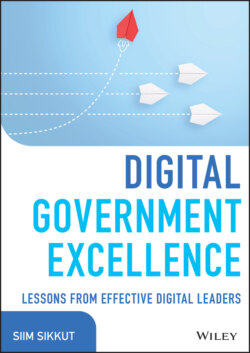Читать книгу Digital Government Excellence - Siim Sikkut - Страница 50
With All This Load Ahead of You, What Did You Start With? What Was the Focus for Your First Months?
ОглавлениеI always start in a position with the people I have in front of me. The first thing was holding all staff meetings regularly, and then booking one-on-one meetings with staff members and especially with a mixture of people I had heard to be “problematic” on the team. Usually, those are the people that are the most frustrated because they want to make the biggest difference. So, I purposely sat down with them first to find out the history, what was going on and not going on, and what they would change.
I also sat down with all divisions and units within the CIO office; I sat down with other CIOs of other departments. It was basically just a lot of listening because I had certain assumptions coming in. You need to talk to people because they are probably the most important leg in this “stool” with three “legs” to digital government and any change: the governance, the tech, the people. People compose the one “leg” that will make it all fall apart if they do not do the work or want to follow—even if you have the best tech stuff and the best governance. I wanted to understand how the people on the team and around us did technology and what were the existing governance processes.
Another thing was to leverage the political support that we had when I came in. For the first time ever, we had in Scott a minister at the Treasury Board who was willing to say “no” to IT projects submitted if the right technology architecture was not being deployed. That veto power had been there before, but the problem was that pulling this lever is the last step. The preferable option is to engage with the department before you get to that point and try to fix it. Pulling the minister veto and sending them back to the drawing board is a very nuclear option. It means that you are delaying programs, delaying services to Canadians.
What we then could do instead is to set direction; for example, departments would have to do things in the cloud. Then six months later we would make sure they were using the cloud. So, we wanted to start with precision direction from a central agency quickly. This took a lot of political leadership at first, as the mandate of policy did not exist at first. So, we quickly started with the longer-term policy renewal and legislative renewal.
I also launched a series of Skunkworks projects—stuff that was close to my chest and that I managed with the staff directly. Things like doing open procurement really quickly, or I wanted an AI policy in place really quickly, or restart having a big govtech conference (which became the FWD50 series). Things like Talent Cloud to change how government hired by taking it down from a year-long process to thirty days and breaking a lifelong career model into six-month bursts where people could come in and out of the civil service more easily.
I kept those close because I wanted to show that we were going to set the tone and how we were going to work differently. I did not want to leave that to anybody else, to have a series of quick wins and special projects that we could start announcing to the world.
